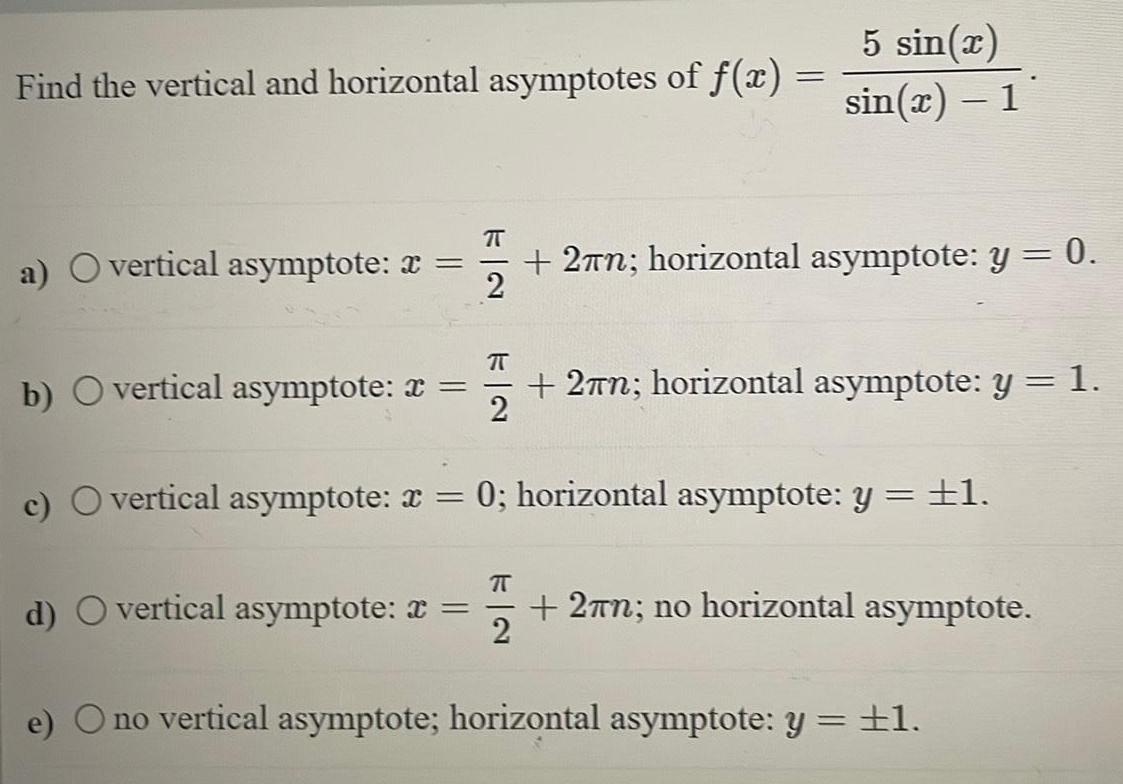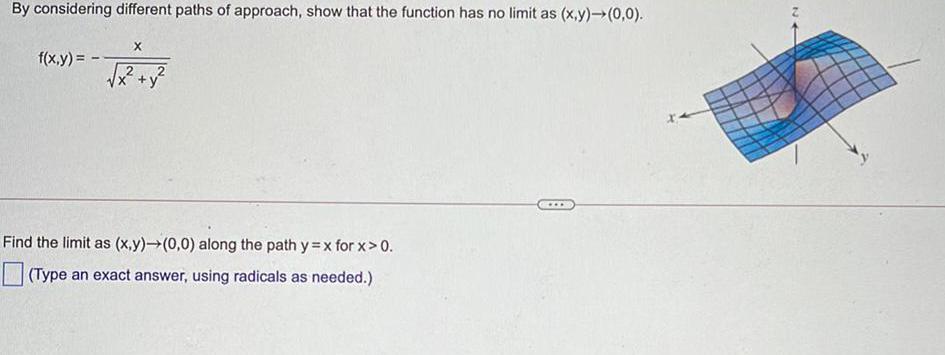Limits and Continuity Questions and Answers
![Does the following function satisfy the preconditions of the Mean Value Theorem on the given interval? Explain why or why not. If so, what is the conclusion of the MVT? If possible, find the point(s) guaranteed by the MVT. Show all your and sketch the graph on the interval and the point(s) you found.
f(x) = tan x; [0,π/4]](https://media.kunduz.com/media/sug-question/raw/56973490-1657563890.936738.jpeg?w=256)
Math
Limits and ContinuityDoes the following function satisfy the preconditions of the Mean Value Theorem on the given interval? Explain why or why not. If so, what is the conclusion of the MVT? If possible, find the point(s) guaranteed by the MVT. Show all your and sketch the graph on the interval and the point(s) you found.
f(x) = tan x; [0,π/4]

Math
Limits and ContinuityFind the vertical and horizontal asymptotes of f(x) = 5 sin(x) / (sin(x) - 1)
a) O vertical asymptote: x =π/2 + 2πn; horizontal asymptote: y = 0.
b) O vertical asymptote: x = π/2 + 2πn; horizontal asymptote: y = 1.
c) O vertical asymptote: x = 0; horizontal asymptote: y = ±1.
d) O vertical asymptote: x = π/2 + 2πn; no horizontal asymptote.
e) no vertical asymptote; horizontal asymptote: y = ±1.

Math
Limits and ContinuityThe average diameter of a bolt produced by a machine is 16 mm. To determine if the sample mean differs from the population mean, a sample of 9 bolts is inspected. The diameters (in mm) of 9 bolts are: 16.020, 16.031, 16.017, 16.024, 16.028, 16.023, 16.025, 16.019, and 16.024. Is there a significant difference between the sample mean and the population mean? (Use: the tabulated t-value for 8 degrees of freedom at a 95% level of significance is 2.31.)
Yes, because 16.02 > 2.31.
No, because 16.02 > 2.31.
Yes, because 1.06 < 2.31.
No, because 1.06 < 2.31.
![Which of the following illustrates
the distributive property?
Enter a, b, c, d, or e.
(xy) (ac+df) =
a. (xy) (acdf)
c. x[y(ac+df)]
b. (xy) + (ac) + (df)
d. (ac + df)(xy)
e. xyac + xydf](https://media.kunduz.com/media/sug-question/raw/72004148-1657472737.5319917.jpeg?w=256)
Math
Limits and ContinuityWhich of the following illustrates
the distributive property?
Enter a, b, c, d, or e.
(xy) (ac+df) =
a. (xy) (acdf)
c. x[y(ac+df)]
b. (xy) + (ac) + (df)
d. (ac + df)(xy)
e. xyac + xydf

Math
Limits and ContinuityBy considering different paths of approach, show that the function has no limit as (x,y)-> (0,0).
f(x,y)=-x/√x2+y2
Find the limit as (x,y)→(0,0) along the path y=x for x>0.
(Type an exact answer, using radicals as needed.)

Math
Limits and ContinuityConsider the following random sample of diameter measurements (in inches) of 11 softballs.
4.69, 4.84, 4.74, 4.71, 4.76, 4.71, 4.76, 4.79, 4.77, 4.79, 4.72
Send data to calculator
If we assume that the diameter measurements are normally distributed, find a 95% confidence interval for the mean diameter of a softball. Then find the lowe
limit and upper limit of the 95% confidence interval.
Carry your intermediate computations to at least three decimal places. Round your answers to two decimal places. (If necessary, consult a list of formulas.)
Lower limit:
Upper limit:

Math
Limits and ContinuityConsider the following.
f(x) = (x-5) / (x² - 25)
Find the x-values at which f is not continuous. Which of the discontinuities are removable? (Enter your answers from smallest to largest. Enter NONE in any unused answer blanks.)

Math
Limits and ContinuitySelect all the toolkit functions below that are discontinuous.
Exponential function
Rational function
Linear function
Logarithmic function
Sine function
Cubic function
Constant linear function
Quadratic function
Square root function
Absolute value function